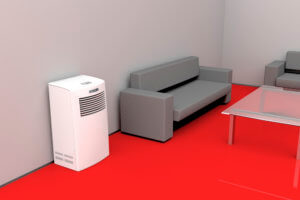
An air purifier helps with house dust allergy – © depositphotos.com @ magraphics
If you take a look around the Environmental Protection Agency, you will find a wealth of information on indoor air quality. In general, it can be said – and this is repeatedly confirmed by studies – that air in enclosed spaces is often worse. This is due to low circulation in the interior and the fact that particles and pollutants accumulate. In this article we will explain how air purifiers can improve the air and also help with asthma, allergies and dust mites.
Bestsellers
The air is getting worse and worse
Industry, traffic and other emission sources distribute tons of fine dust and other particles, as well as chemical gases, in the air every day. At the same time, nature spreads its pollen, especially in spring and summer. These particles and dusts penetrate into the interior where they are distributed in the indoor air and settle on the furniture.
Inside closed rooms there are also other sources that deteriorate the indoor air. Cigarette smoke is obvious, but no one thinks of the outgassing that often occurs with new furniture, for example. In addition, there is the ubiquitous house dust, especially indoors, which has combined with the excrement and the remains of the dust mites. In the long run, all this damages our lungs.
Remedy through air purifiers
Air purifiers and air washers are devices that improve the air quality in rooms. These devices are especially recommended for allergy sufferers, but also for people with multiple chemical sensitivity (MCS disease). In many cases one still meets with rejection in this country and hears: “I don’t need something like that! Other countries, such as the USA, Canada and Great Britain, are much further along in this respect. Here, air purifiers belong in the home just as the vacuum cleaner does here.
What does an air purifier do?
Air purifiers are particularly good at binding dust and the smallest particles. This is ideal for allergy sufferers, regardless of whether you are allergic to house dust or pollen. Depending on the system, house dust and pollen are trapped in a filter or passed through water and bound there. The latter devices are then also called air washers.
Air purifiers with a so-called HEPA filter promise to remove 99.9% and more of particles with a size of 0.3 µm from the air. Therefore, HEPA filters are standard in most devices. We recommend purchasing a device with an additional pre-filter so that you do not have to replace the expensive HEPA filter so often.
Air washers cannot remove quite as much dust. Nevertheless, these devices are quite justified, especially for people with hay fever and asthma. The air is reduced only by mould spores and pollen, as well as some house dust, but especially the air humidification by the air washer has a cough-irritating and soothing effect on asthmatics during the heating period.
Air purifiers are usually not so good with chemical gases. Although there are some professional devices that can also partially filter chemical substances, this never works completely. As a rule, it is neither known which substances are currently in the air, nor do such filter systems last for a long time without extensive maintenance.
There are also manufacturers that use ultraviolet light as a cleaning method. Although it is recognised that UV light can sterilise, it is questionable whether the short flow of air in the room is actually sufficient to sterilise it. However, this type of cleaning is definitely harmless.
What should you look for in a good air purifier?
If you compare air washers and air purifiers, you will quickly realize that air purifiers tend to be more expensive than air washers. This is especially due to the fact that an air purifier uses more complex technology to clean the air. Accordingly, however, the result is also better in terms of dust removal, so that we recommend an air purifier to all house dust allergy sufferers.
To purchase a good air purifier, you need to pay attention to a few things:
- How big is the room?
- How loud is the device?
- How high are the follow-up costs (filters and energy consumption)?
- Can the device be easily transported to other rooms?
It is the size of the room that is decisive for a good result. Too small devices lead to the result not being the desired one. By the way, the best way to calculate the volume of a large room with high ceilings is to first calculate the room volume (room size x height = volume). Then make sure that the selected unit has this volume of flow around twice per hour.
The volume of a device is important. Even if in the living room the noise level of the device is usually not perceived as disturbing as quickly, such devices often disturb the sleep in the bedroom. Only devices between zero and 10 dB are almost inaudible, up to 20 dB are called quiet devices. We recommend that you order the desired device on the Internet. It is so loud that you can still exercise the right of withdrawal.
With the follow-up costs, you should especially look at how expensive it is to change the filter. Some providers charge ten euros, others 30 € and more. That can then go faster into the money, than one would like.
But the electricity consumption of an air purifier should also be taken into account. Real power guzzlers can quickly cost money if you consider that the air purifier should run daily throughout the year.
Letzte Aktualisierung der Amazon-Preise am 2024-11-29 | Preise können sich inzwischen geändert haben Affiliate Links & Bilder von der Amazon Product Advertising API | Preis inkl. MwSt., zzgl. Versandkosten
